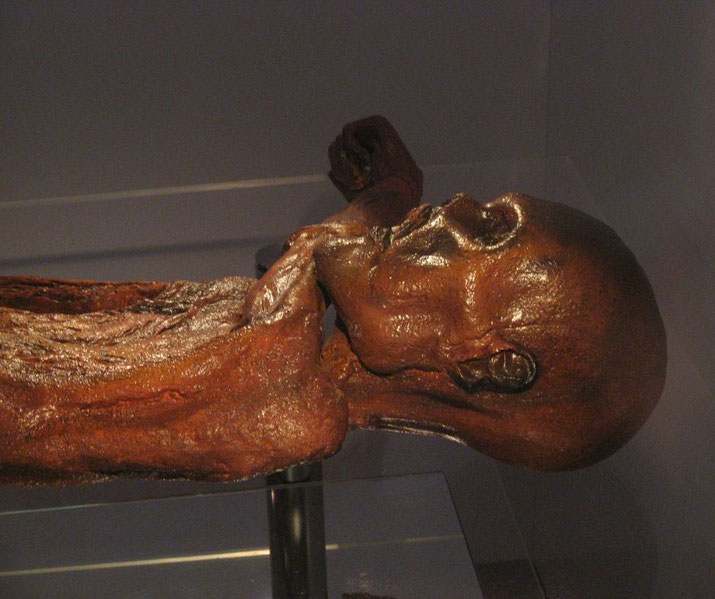Who was Otzi the Iceman?

In 1991, hikers in the Ötztal Alps, near the border between Italy and Austria, made a shocking discovery that would change our knowledge of human history forever.
While they didn't know it at the time, they would stumble across a remarkably well-preserved body of a person who had been alive more than 5,300 years ago.
This ancient person would later be named Otzi the Iceman and his remains have become one of the most important sources of information about what the lives of human were like long before the invention of writing.
How was Otzi discovered?
On the 19th of September 1991, two German tourists, Helmut and Erika Simon, were on a holiday hike in the Tisenjoch pass in the Ötztal Alps, near the border between Austria and Italy.
They had reached an altitude of 3250 m (approximately 11000 ft) on a glacier, when they noticed a brown-coloured object stuck in the ice and snow in front of them.
As they investigated further, they were shocked to discover a human body, lying face down and mostly still covered by ice and snow.
It appeared that recent environmental changes had begun melting the environment around him, which meant that parts of his body, particularly his upper torso, were suddenly exposed.
Initially, the hikers thought they'd come across the body of a recent hiker who had succumbed to a fall and contacted the authorities.
Police who attended the scene quickly noticed that the strange clothing and significant aging of the body indicated that this was no ordinary hiker but an ancient man.
Archaeologists were then brought to the scene and the work of removing trying to preserve the decaying body as carefully as possible began.
However, no one was prepared for the sheer age of the person they'd found.
Once back in the lab, radiocarbon dating has established that the man, dubbed 'Otzi' after the mountains he was found on, had lived around 3,300 BCE, making his remains over 5,300 years old.

The incredible artefacts found with Otzi
As the archaeologists removed the ice and snow around Otzi's body, they discovered a range of fascinating items that appeared to be associated with him.
Due to their immense age, many of them were fragmented and fragile. Therefore, the process of finding and preserving them was a painfully slow one.
However, they were able to save a vast array of them. Among the artifacts found with Otzi was an axe made with a thick copper blade and a yew handle.
Also, there was a knife with a flint blade and an ash handle, along with a deer skin quiver and two broken arrows.
One interesting thing the scientists noted was that the arrows were not found in his quiver.
They were in a pack he carried with him. The two broken arrows were stored inside, along the 12 other unfinished arrow shafts.
Otzi also had a primitive first-aid kit, which appeared to contain traces of plants which had medicinal properties.
Otzi also had a primitive first-aid kit, which appeared to contain traces of plants which had medicinal properties.
Also, he had a kind of 'fire-starting kit', which was a piece of coal wrapped in leaves.
It is thought that he carried the still-hot coal with him to help start fires when required.
Much of his clothing was also preserved, which allowed archaeologists to see what ancient humans were wearing at the time.
Specifically, Otzi wore a cap made from bearskin, a warm cloak sheep's wool, a sheep skin coat, a belt, goat skin leggings, and shoes made from cattle leather.
The remarkable range of items found with Otzi indicate that he was probably a wealthy and important person, as they would have taken a significant time to acquire.
Why was Otzi and his items so well preserved?
The glacier that encased Otzi created a natural freezer environment, which effectively protecting his body from the decay that typically follows death.
This is due to the constant low temperatures that slowed down the decomposition processes that would have otherwise deteriorated his remains.
For over 5,300 years, his body remained frozen, effectively halting the growth of bacteria and fungi that contribute to decomposition.
Additionally, the ice shielded Otzi from the harsh environmental factors that could have damaged his remains.
The snow and ice layers protected him from scavengers and preserved even the smallest details of his clothing and artifacts.

In fact, Otzi's researchers can still see 61 individual tattoos on his skin. Curiously, they were arranged in 19 groups of designs, many of which are located over areas of physical damage and degenerative disease, which suggests they may have been used for therapeutic purposes similar to acupuncture.
And since Otzi was quickly covered by snow and ice after his death, this natural preservation process began almost immediately.
Ultimately, it prevented exposure to air and moisture, which are primary catalysts for decomposition.
As a result, the Alpine environment, with its dry and cold climate, shielded Otzi and his belongings from the seasonal thawing and refreezing cycles.
Today, Otzi is currently on display at the South Tyrol Museum of Archaeology in Italy.
His body is kept in a specially designed chamber that controls the temperature and humidity.
This chamber allows visitors to see Otzi without damaging his fragile remains.
Scientific analysis process
Ever since his discovery and the incredible news of what the archaeologists had found, the body of Otzi has been the subject of ongoing scientific study.
With each new examination, increasingly more information is discovered about the life of this ancient human being.
For example, an isotope study of the copper axe suggests that it was made in area that is now southern Austria.
Also, scientists discovered that Otzi's stomach appeared to still have food in it.
They were able to examine the contents in order to discover what he ate as his last meal before he died.
In it, they discovered ibex meat and grains. Specifically, he had eaten einkorn wheat, with traces of ferns.
These foods suggest he may have been an accomplished hunter, as meat had to be eaten fresh at the time.
Furthermore, a study of pollen and plant remains that had been caught in his clothing provided crucial information about the regions he had travelled through in the weeks before his death.
Finally, scientific analysis has revealed that Otzi suffered from various physical ailments.
His joints showed signs of arthritis, while other parts of his body had parasitic infections, dental issues, and even evidence of rib fractures that had healed in the past.
What can we know about Otzi's life?
Based upon the unbelievable details preserved in Otzi's body and artefacts, along with the comprehensive scientific analysis, historians are able to paint a picture of who this man was and the life he had led.
Today, research believed that Otzi 'the Iceman' was between 45 and 50 years old at the time of his death.
He was approximately 160 cm tall (just over five feet) and weighed around 50 kg (about 110 pounds).
Otzi had brown eyes, type-O blood, and probably lived in the region now known as South Tyrol in Italy.
DNA analysis indicates that Otzi was lactose intolerant, which was very common in humans at this point in history.
This is because he lived during the Copper Age: an important transitional period in the past when humans were beginning to use metal tools and develop tolerance for eating dairy products like milk and cheese.
In addition, it appears that Otzi had a natural predisposition to cardiovascular disease.
This meant that even if he hadn't died under mysterious circumstances in the Alps, he may have perished from a heart attack within the next ten years.
What, or who, killed Otzi?
One of the most famous discoveries made during the analysis of Otzi's remains, was the evidence that he may have been murdered.
People have proposed this since there were a number of clear injuries on the body that were inflicted just before he died and was frozen.
Firstly, a dislodged arrowhead was found in his back, just behind the left shoulder.
It had been shot into his body and had severed a major artery, which would have caused significant blood loss.
In addition, Otzi had deep wounds across his hands, which appear to have been made by a sharp blade.
Some researchers suggest that he had been trying to defend himself from attackers and that their weapon wounded his hands.
For this reason, historians believe that Otzi was involved in a struggle shortly before his death.
Researchers also found evidence of a blow to his head, which may have occurred during the altercation or shortly after the arrow struck.
This head trauma could have knocked Otzi unconscious or even severely incapacitated.
In light of this, it is likely that his assailants left him to die in the harsh conditions of the Alps.
Even though there is overwhelming evidence that Otzi met a violent end, the cause of his death is still not entirely clear.
Most of the debate is focused on the reason that another person, or group of people, might have harmed him.
The most popular theory about Otzi's death is that he was killed by a rival tribe or had had a disagreement with the people whose lands he was travelling through.
Alternatively, he may have just fallen victim to robbers or bandits who thought that he was an easy target.
However, this theory doesn't explain why Otzi's most valuable items were left with him.
Any robbers would have taken the extremely expensive axe and arrows to either sell or use for themselves.
As a result, there may have been another reason for his death. It is possible that Otzi was the victim of a ritual sacrifice.
In this scenario, the valuable items would have been left as part of the offering to a local god.
Finally, some people propose that he might have simply had an argument with a close travelling companion.
In this scenario, there would have been a scuffle that turned deadly, and in a fit of anger, the assailant left him to die in the harsh conditions of the Alps.
With a combination of blood loss and head injury, Otzi would have been unable to move or seek shelter, making it impossible for him to survive.
If this is true, the valuable artefacts would not have been taken, as the attacker would have known people who would have been able to identify the original owner.
As a result, everything would have been left with the body to hide any evidence of the murder.
Whoever it was that caused the death of Otzi, they could never imagine that evidence of that fateful event would finally be uncovered over 5000 years later.
What do you need help with?
Download ready-to-use digital learning resources
Copyright © History Skills 2014-2025.
Contact via email
With the exception of links to external sites, some historical sources and extracts from specific publications, all content on this website is copyrighted by History Skills. This content may not be copied, republished or redistributed without written permission from the website creator. Please use the Contact page to obtain relevant permission.





